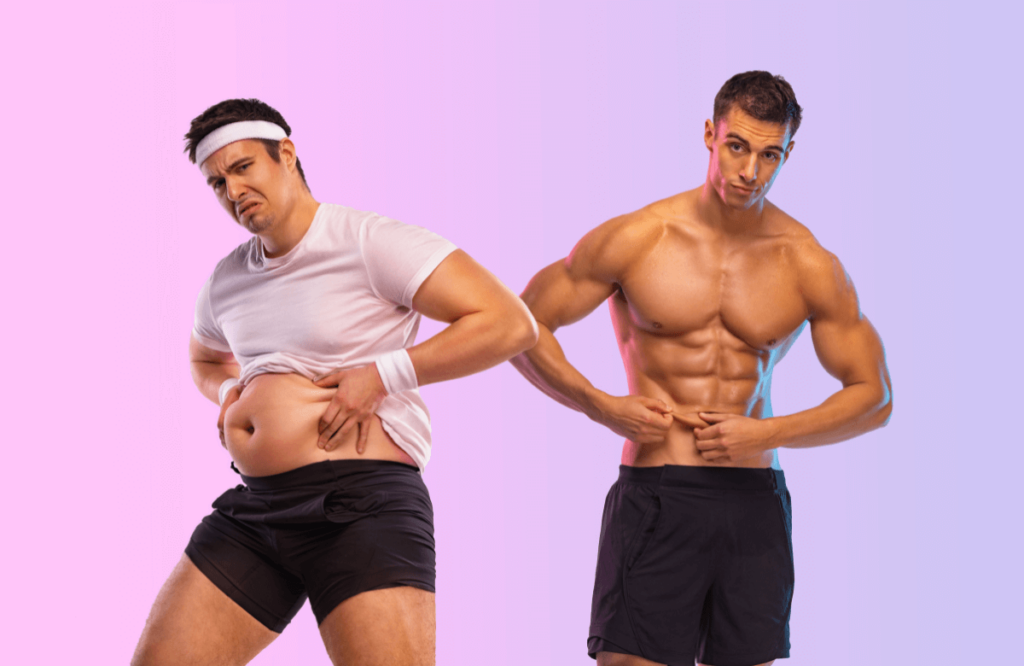Do you feel overwhelmed with all the different diets available for losing weight and gaining muscle? It can make it difficult to know how to approach this.
To make it worse, you can end up choosing one and investing time, money, and effort with little results.
Today I’ll walk you through everything you need to know about a muscle-gaining and weight loss diet that works.
Jump to:
What does it mean to lose weight and gain muscle?
Losing weight and gaining muscle might seem like conflicting goals, but they can work together with the right approach.
To lose weight, you have to burn more energy than your calorie intake. You do this when you eat less than what you take in (energy-wise). This is also called a calorie deficit and is a good option for anyone that still wants to remove some body fat without losing muscle strength or tone. This deficit encourages your body to use stores of fat for energy while you workout to preserve and build muscle.
If you burn more energy than you consume, you can lose weight very quickly, however, doing this can harm your health when taken to the extremes.
To gain muscle, you actively challenge your muscles with resistance exercises like weightlifting, cross-fit, or calisthenics. As you work out, your muscles adapt and grow stronger, which leads to a more toned appearance, more weight loss and better overall health.
Combining these two can lead to great benefits (which we’ll go over soon).
Is body recomposition for everyone
Body recomposition primarily depends on your goals and where you are starting from. If you’re looking to shed some excess fat and tone up your muscles (get a beach body), it can be a great approach. With this approach, you balance your calorie intake with your workouts to make sure you are taking in as much as you put out.

However, it’s important to note that body recomposition may not be the fastest way to see results. If you have a lot of weight to lose, it’d be better to opt for a calorie-deficit approach to your diet combined with lots of cardio. If you have a strong desire for substantial muscle gain, then you’ll want to go into a calorie surplus, lift weights and avoid cardio.
Cut & gain vs bulking
To bulk is to go into a calories surplus so that you give your muscles more than enough nutrients and energy to grow. Weightlifting and resistance training are your best friends during this phase, as they stimulate muscle growth.
But keep in mind, when you bulk, you may also gain some fat along with the muscle mass. It’s a trade-off for maximum muscle growth. However, a lot of people will bulk for a period of time and then transition to a “Cut & Gain” phase to trim down and reveal the hard-earned muscles.
Cut & gain vs lean bulking
“Lean Bulking” is a smart strategy for those who want to gain muscle while minimizing fat gain. With this approach, you consume a moderate surplus of calories to give your muscles the extra nutrients and energy they need to grow. However, the key here’s moderation using a controlled calorie surplus.

Both approaches have their merits, and your choice depends on your specific fitness goals and where you currently stand on your fitness journey.
How to lose weight?
The fitness and health world is full of “what ifs” and a sea of controversies when it comes to losing weight. But fear not, we’re here to shed light and help you separate fact from fiction.
- Diet is king for weight loss. That means plenty of fruits, vegetables, lean proteins, and whole grains. Avoid excessive processed foods, sugary drinks, and unhealthy fats. The best way to do this is to make it a sustainable diet that you can follow for life.
- Exercise is your trusty weight loss companion. Use a mix of cardiovascular exercise (like running, swimming, or cycling) and strength training (such as weightlifting or bodyweight exercises). Cardio burns calories, while strength training builds and maintains muscle and also burns calories.
- To drop pounds, you need to create a calorie deficit. Aim for a safe level of 200–400 calories less than what you normally consume. Keep in mind that this deficit can be achieved through a combination of eating less and moving more.
- Cardio workouts are fantastic calorie burners. They elevate your heart rate, help to burn more energy, and can help you lose lots of fat.
How to gain muscle?
Now let’s turn our attention to the equally important journey of gaining muscle.
- Weight training lies at the heart of muscle gain. This can come from body weight exercises or with actual weights; the principle is the same, create resistance. When you lift weights or challenge your body against gravity, you create micro-tears in your muscle fibers. As they repair, they grow stronger and larger.
- This might sound controversial, but rest and recovery is equally critical to growth. When you sleep, your body releases growth hormones that aid muscle recovery. So, prioritize both quality sleep and days off from intense workouts.
- Protein is the building block of muscle tissue. Eat plenty of protein from protein sources like chicken, fish, lean beef, tofu, or beans in your diet. A general guideline is to aim for 0.54 to 1.0 grams of protein per pound of body weight.
- Carbohydrates are your body’s primary energy source, and are necessary for intense workouts. Opt for lots of complex carbohydrates like whole grains, fruits, and vegetables a day or few hours before a big workout. They release energy steadily and help sustain you throughout your workout.
Benefits of losing weight while gaining muscle
Next, let’s go over how this magical combination works and why it’s so rewarding.
Going into a calorie deficit prompts your body to tap into its fat stores for fuel. As a result, the extra pounds start to melt away (especially those stubborn love handles). And when you break down and build muscle tissue, you use way more energy than it takes to maintain the fat. So, when you work on muscle through resistance training, your body becomes a calorie-burning furnace.
Muscle is metabolically active tissue, which means it’ll burn calories even when you’re not working out. The more muscle you have, the higher your basal metabolic rate (BMR). This translates to more calories burned throughout the day, making it easier to maintain a healthy weight.
Losing weight and gaining muscle simultaneously reshapes your body. As fat disappears, your muscles become more visible, which can lead to a leaner and more sculpted appearance.

Lower body fat percentages reduce the risk of obesity-related diseases like diabetes and heart disease. And, the strength you gain from muscle growth improves overall functional fitness and reduces the risk of injuries.
How to lose weight and gain muscle: the diet
To achieve these benefits, your diet plays a pivotal role. It’s about the right balance of high-quality food that nourishes your body as you progress.
1. Let’s talk protein
As we mentioned, your body builds muscles using protein which is filled with amino acids as the building block. It also burns more calories to eat any protein you take in than fats and carbs, so you burn more even while at rest. All this means that LOTS of protein should be the main source of your diet.
Aim to include high-quality protein sources in your meals. Think in terms of:
- Chicken breasts (great for chicken sandwiches and chicken parm)
- Fish (Talapia, Salmon and Tuna have the highest protein per gram)
- Lean beef
- Tofu
- Kidney beans (great for plant-based proteins)
- Black bean (nutrient dense)
- Whey protein
- Cottage cheese
- Greek yogurt
The general guideline is to aim for 0.54 to 1.0 grams of protein per pound of your body weight. So, if you weigh 165 pounds, aim for between 84 to 154 grams of protein daily. If you’re more focused on significant muscle gain, then you’ll want to up your protein intake. Shoot for the higher end of the scale, around 0.77 to 1.0 grams of protein per pound of body weight.
It’s also a good idea to space your daily protein intake throughout the day. Include it in your breakfast, lunch, dinner, and even as snacks. These consistent servings of protein supply makes sure your muscles have a steady stream of materials for growth and repair.
Remember, protein isn’t just for bodybuilders or athletes; it’s important for your overall health.
2. Next, veggies & fruits
Just like a car needs the right fuel to run efficiently, your body requires a variety of nutrients to function optimally.
Fruits and vegetables are packed with vitamins, minerals, and antioxidants. After you workout or do cardio, your body needs these nutrients to recover and become stronger.

Eating a lot of fruits and veggies is a great way to get dietary fiber. Fiber aids in digestion while also making sure you stay full and content. This is especially beneficial for those who are trying to manage their caloric intake but remain healthy.
Include a variety of fruits and veggies in your diet, makes sure that you get a wide range of nutrients. For example, oranges provide vitamin C for immunity, while spinach offers iron for energy.
For good muscle growth and weight loss fruits and veggies, think about these:
- Blueberries
- Bananas
- Oranges
- Apples
- Berries (Strawberries, Raspberries) are low in calories and high in fiber
- Broccoli
- Baked potatoes (high carb count per gram)
- Spinach
- Bell peppers aid in collagen production
- Sweet potatoes are high in complex carbs, and they’re carb-dense (most grams of carbs).
- Kale is a nutrient powerhouse, with vitamins, minerals, and antioxidants for overall health and muscle recovery
To practically apply this information, aim to fill half your plate with fruits and vegetables at each meal. Try fresh salads, smoothies, green veggies bowls, or roasted veggies as tasty ways to include these power-packed foods in your diet.
3. Vegan options
Now, let’s explore some fantastic vegan options for those who prefer plant-based sources of protein.
Plant-based protein foods include:
- Tofu
- Tempeh
- Lentils
- Chickpeas
- Quinoa
- Almonds,
- Peanuts
- Chia seeds
- Hemp seeds
A sample vegan diet for muscle gain and weight loss might include:
- Breakfast: Tofu scramble with spinach and tomatoes
- Lunch: Lentil and quinoa salad with lots of veggies
- Snack: A handful of almonds and a piece of fruit
- Dinner: Chickpea curry with brown rice
- Dessert: Greek yogurt with berries (for added protein)
4. Snack time
Snacking can either support your weight loss and muscle gain goals or derail them, depending on your choices.
Choose protein-rich snacks like Greek yogurt, cottage cheese, or a handful of almonds. These snacks also provide a steady supply of amino acids to support muscle growth and repair.
Fruits, especially those high in fiber like apples and berries, make excellent snacks. They also help to keep you feeling full.
For a quick energy boost before a workout, consider a snack with complex carbohydrates like whole-grain crackers or a banana.
5. Foods to avoid
Now that we’ve covered what to include in your diet, it’s equally important to know what to avoid.
- Processed foods and fast foods are often high in empty calories, unhealthy fats, and added sugars
- Beverages like soda, energy drinks, and even some fruit juices are loaded with sugar
- Cakes, pastries, and candies are just empty calories
- Alcohol ruins your metabolism and muscle growth
6. Example diet for weight loss and muscle gain
Next, let’s put it all together with an example diet that combines weight loss and muscle gain strategies.
Breakfast
- Scrambled eggs with spinach and tomatoes (or a tofu scramble for a vegan option)
- A serving of Greek yogurt with berries
- A slice of whole-grain toast
Lunch
- Grilled chicken or tempah salad with mixed greens, and colorful veggies
- A side of quinoa or brown rice
Snack
- A handful of almonds or a piece of fruit
Dinner
- Baked salmon or a plant-based protein source like chickpeas
- Steamed broccoli and asparagus
- A sweet potato or brown rice
Snack (if needed)
- Greek yogurt with a drizzle of honey or a small serving of cottage cheese
How to lose weight and gain muscle: the workout
In terms of training alot of it’s going to come down to each person’s preferences. Some prefer more cardio; some like body weight, and others use equipment, or weights. This means we’ll rather focus on the basics instead of going to deep into the specifics of each style.
1. Balance your workout with your diet
You should strike a balance between your workout routine and your diet for your specific weight loss and muscle gain goals. See your daily calorie intake as the fuel for your body, and your workout as the vehicle that consumes that fuel. If you consume 2,500 calories per day and burn 2,500 calories throughout the day, any additional workout can then create a calorie deficiency.
Calculate your daily energy expenditure, add in your workout routine, and aim to adjust your calorie intake accordingly. If you’re currently carrying excess weight, strive for a calorie deficit. If you’re already lean, aim to match your calorie intake to your energy expenditure and up your protein per gram intake.
2. Let’s talk about cardio
Cardio increases your heart rate, helps in calorie burning, and can lead to weight loss.
The type of cardio you choose will determine how many calories you burn. High-intensity cardio activities like running, cycling, or swimming can burn a substantial amount of calories in a short time. On the other hand, low-intensity cardio activities like walking are gentler on the body and sustainable for longer periods.
The key is to work your cardio into your routine in a way that complements your diet. If you’re aiming for weight loss, focus on a mix of high and low-intensity cardio sessions to create a calorie deficit.
3. Weight training
Weight training is going to be an essential part of your fitness routine, especially if you want to gain muscle. Here preferences will come into play so what you do is up to you.
To get started with weight training, you can use dumbbells, barbells, or machines at the gym. Bodyweight exercises such as push-ups, squats, and lunges are great for those who are just starting out or who prefer to exercise in the comfort of their own home.
FAQs
What protein burns the most fat?
There’s no specific protein that directly burns fat. However, eating mainly lean proteins like chicken breast, fish, and tofu can help with fat loss indirectly. Protein helps you feel full and can boost your metabolism slightly so you can, maintain a calorie deficit for weight loss.
What 3 foods burn the most fat?
Certain foods can help with fat loss due to their nutritional properties and impact on metabolism.
Three of these foods are:
Green tea as it contains antioxidants and caffeine that may increase fat burning and improve metabolism.
Chili peppers contain capsaicin, which can temporarily boost your metabolism rate and promote fat oxidation.
Lean proteins require more energy to digest, which can help with fat loss.
Which food is the king of protein?
Lean meats like chicken breast, turkey, and fish are often thought of as the “kings” of protein. They’re low in fat, high in protein per gram, and are a high-quality source of essential amino acids. But, for plant-based sources look at foods like tofu, lentils, and quinoa.
What fruits burn fat?
While no fruit directly burns fat, some fruits can support weight loss due to their low-calorie and high-fiber nature. Examples include berries (strawberries, blueberries, raspberries), apples, and oranges. These fruits help control appetite and keep you feeling full.
Which protein is best for weight gain and muscle gain?
Whey protein is a complete protein and one that the body can easily digest. Casein protein is another option, particularly useful before bedtime, as it is a slow-release source of amino acids. Plant-based options like pea protein or rice protein can work for vegans.














